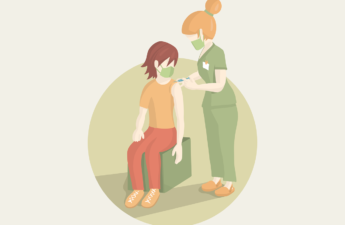Rural Opportunity Deserts
By April Simpson, Kaiser Health News
After two weeks of “mental toughness” training, 20 teenagers and young adults in a YouthBuild daily program in Enid, Oklahoma, were on the cusp of turning their lives around.

Out of school and out of work, they proved to organizers that they could be punctual, follow instructions and work hard. As a result, the youths were invited to the next phase of the program: working toward earning their high school diplomas and helping with local construction projects.
“They were super excited to have been chosen,” said Rachel Harris, program coordinator. Then the coronavirus hit, and the program closed its doors. “It was just a few days later that we had to break the news to them and send them home.”
Jiliane Ford, 19, took it hard. “I really liked getting to go back to school and then it was just ripped away.”
Disconnected youth like Ford hunger for attention. Stay-at-home orders have set them adrift.
In-person contact is integral to many of the workforce training and alternative education programs available to them. And because many participants don’t have laptops or reliable broadband access, remote learning isn’t a viable option.
Across the country, an estimated 4.5 million youth ages 16-24 are considered disconnected — not going to school or working, according to an April 2019 report from Measure of America, a project of the Social Science Research Council, a research nonprofit based in Brooklyn.
And as policymakers take steps to help Americans recover from the economic and social ramifications of the pandemic, advocates say those young people are in danger of being further left behind.
The rate of disconnected youth declined from 14.7% in 2010 to 11.5% in 2017, thanks to a growing economy and successful high school retention efforts. But the youth disconnection rate tends to track closely with the national unemployment rate, which J.P. Morgan predicts will skyrocket to around 15%. Some economists expect the rate to eventually exceed a Great Depression-like 25%.
The challenges are most severe for rural, black and Native American populations, who are over-represented in the disconnected population. Before the pandemic, nearly a quarter of Native American youth were disconnected. The rate among African Americans was 18%.
The rates were lower among Hispanics (13.2%), whites (9.4%) and Asian Americans (6.6%), according to Measure of America.
“When the economy reopens, it will not necessarily be reopening for these young people,” said Kisha Bird, director of youth policy for the nonpartisan Center for Law and Social Policy in Washington, D.C., a think tank focused on low-income people.
Disconnected youth are more likely to be poor and disabled, and to have interacted with the criminal justice system, according to Measure of America.
They go on to earn about $30,000 less a year than their counterparts who are in school or working. Their parents typically received little education.
Prior to the pandemic, a quarter of rural youths in isolated places were disconnected, but as many as a third were disconnected in the Mississippi Delta or the Big Sandy area of eastern Kentucky, according to a Measure of America report that will be released this month.
These isolated “rural opportunity deserts” tend to be racially homogenous and have limited economic activities and public services, said Kristen Lewis, director of Measure of America. Local service-providing organizations often are poor.
Although youth disconnection tends to be considered an urban affliction, a 2017 Stateline analysis found higher shares of disconnected youth since 2011 in rural areas.
In completely rural counties, the youth disconnection rate was about 20%, compared with about 14% in cities, according to Measure of America.
West Virginia has had the highest rate of youth disconnection (17%), followed by New Mexico (16.5%) and Mississippi (16.4%).
Advocates fear that the pandemic will increase those numbers.
“A lot of programs are just closing and they don’t have any opportunities to engage their young people,” said Adam Strong, a national advocate for disconnected youth and an alumnus of YouthBuild and AmeriCorps in Eastern Kentucky. “The online opportunities aren’t there. The infrastructure isn’t there. They don’t have the funds for that.”
Cord Bueker Jr., workforce policy analyst with the Oregon Youth Development Council, expressed similar concerns.
“There’s going to be this five-month gap between when a lot of young people set foot in their high school and potentially return in the fall,” Bueker said. “That will pose a big challenge, particularly for youth whose attachment to school was tenuous.”
Programs Adapt
Without an in-person component, Harris’ program in Enid transitioned to virtual learning. But not all the students have laptops or computers. If they had cellphone service, it was likely cut off for nonpayment; most of the youth go through cycles, turning cell service back on when they receive a paycheck. Many weren’t able to receive messages unless they went to a McDonald’s that had free Wi-Fi, Harris said.
The sudden changes frustrated Ford, who had just gotten her 3-year-old son Cash on a schedule.
“That’s one thing about the YouthBuild people; they’re very understanding when it comes to kids,” she said. “When I dropped out of school when I was pregnant, they didn’t care about me having a kid.”
Over three weeks, the program asked the young people to pick up homework packets. But that created problems too. Despite social distancing orders and staggered pickup times, they congregated. Then the program tried mailing packets. Eventually, a local internet service provider offered free internet, and YouthBuild organizers obtained board approval to buy and distribute Chromebooks.
“I specifically went to YouthBuild to get off of online [learning] and that’s probably the hardest part of it all,” said Alex Powers, 20. “It’s really hard to stay focused at home.”
Now the program starts each day with a virtual Zoom meeting. The structure helps to anchor the students in some normalcy, Harris said. But it’s tougher to keep this population engaged when they need individualized instruction to address varied needs.
Some of Harris’ young adults and teens have been out of school for more than five years. Others never attended high school. Some read at an elementary-school level. Others have low math scores. There’s tutoring offered over Zoom, but “it’s not as good as it was,” Harris said.
“My fear right now is that we’re going to lose some of them because we are running a program that they didn’t sign up for,” Harris said.
Alternative education and youth programs like YouthBuild receive guidance from the U.S. Education and Labor departments or the Corporation for National and Community Service. Federal money helps pay for the programs and for stipends to participants.
But advocates say some federal guidelines and resources failed to address their challenges, such as how to transition to virtual training when many participants lack reliable broadband, the tools to access it or even stable housing.
“There was no guidance, and there was no context,” said Kim Phinney, a senior fellow with the Center for Rural Strategies and former vice president of program design for YouthBuild USA. “No one checked in with them around what this experience would look like for rural and Native communities. Was it even viable? What would it take to do that?”
Youth employment counselors with the Central Oregon Intergovernmental Council are doing weekly homework pickups and drop-offs at students’ homes. It takes one counselor more than six hours to visit 14 students in the rural Prineville area.
In a letter to agency leadership, the Center for Law and Social Policy and the National Youth Employment Coalition asked the Department of Labor to issue guidance to state and local workforce boards that are confused about whether they can authorize stipends to youth who are unable to participate in programs. They also want clarification that programs can spend money on emergency cash assistance, food, laptops and radio and social media ads.
Youth in the Oregon program are no longer receiving their federal stipends because they’re not working, said Josh Lagalo, a youth education and training manager.
“They are unable to earn that 18 hours a week of income which is huge because some of the youth we work with, they’re giving those funds to their parents for bills,” Lagalo said.
A Labor Department spokesman did not respond to a request for comment for this story.
Meanwhile, some organizers worry they may not be able to meet federal program requirements. For example, the Work Innovation Opportunity Act of 2014, or WIOA, requires youth service programs to spend 20% of their budgets on youth work experiences. With stay-at-home orders, that’s impossible.
“Ideally [the Department of Labor] would be offering some flexibility on getting out from under a requirement like that,” said Thomas Showalter, executive director of the National Youth Employment Coalition. “And I think they hear us; it’s just given the context, the political leadership over there, I’m not sure they’re going to do anything proactive.”
Grant requirements worry organizers like Harris. Enid is expected to reopen Friday under the city’s return-to-normalcy plans. But YouthBuild won’t have students back in the building till June. She still needs to fill nine more slots for students to fulfill grant requirements.
“It’s something that does loom over me right now,” Harris said. “We’re not where we need to be.”
Kaiser Health News, a nonprofit health newsroom whose stories appear in news outlets nationwide, is an editorially independent part of the Kaiser Family Foundation.


